K–12 Exterior Door Labeling Guide: Safety, Consistency, and Emergency Preparedness
When labeling exterior doors across your school district, the single most important factor is consistency.
Whether you're launching a new safety initiative or improving an existing system, establishing a consistent, scalable door labeling standard is critical—especially when managing multiple campuses with varying architectural styles and layouts.
Why Door Labeling Matters
Auditing and Accountability Labels make it easier to inspect, track, and verify the functionality of exterior doors during regular safety audits. Clear identifiers help maintenance teams document issues, monitor repairs, and ensure compliance with district and state requirements.
Emergency Response In critical situations, every second counts. Clearly labeled doors provide first responders with precise reference points for accessing specific locations on campus—reducing confusion, improving coordination, and potentially saving lives.
Understanding Campus Layout Types
1. Single-Building Schools
Typically consisting of a single structure with one main entrance and no auxiliary buildings. These campuses are the easiest to label.
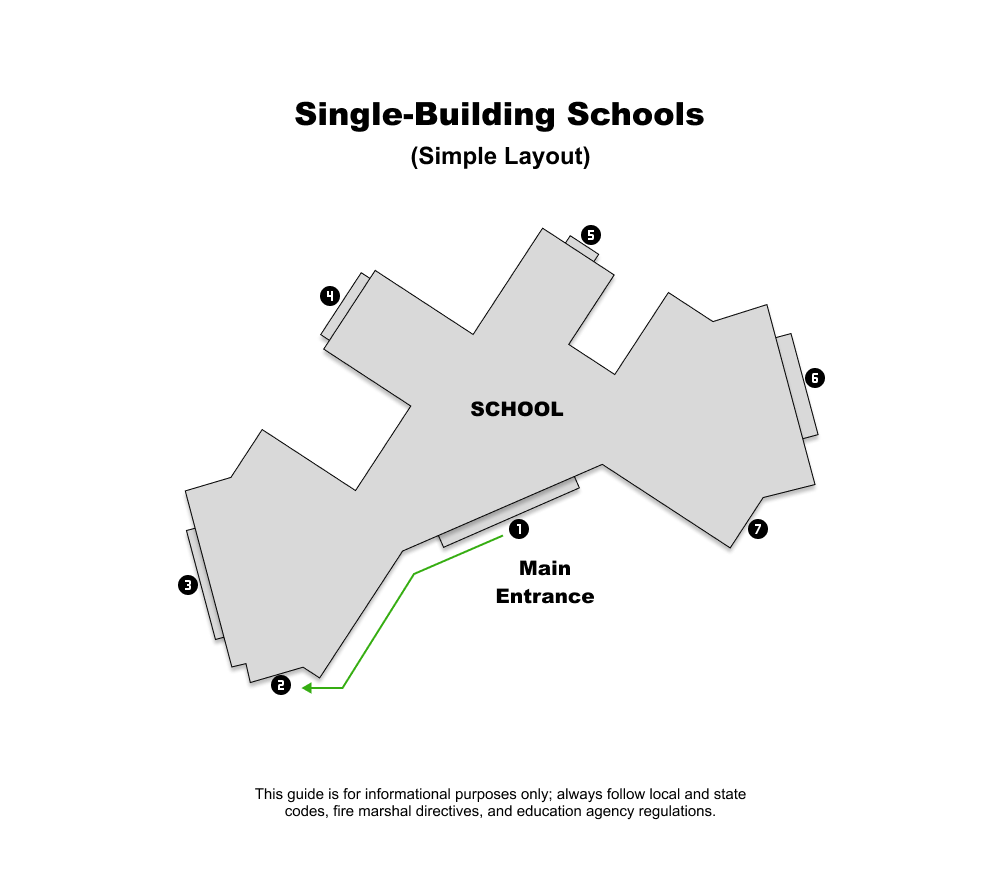
2. Multi-Building Schools
Common at the middle and high school levels, these include multiple permanent structures such as gyms, cafeterias, and classroom wings.
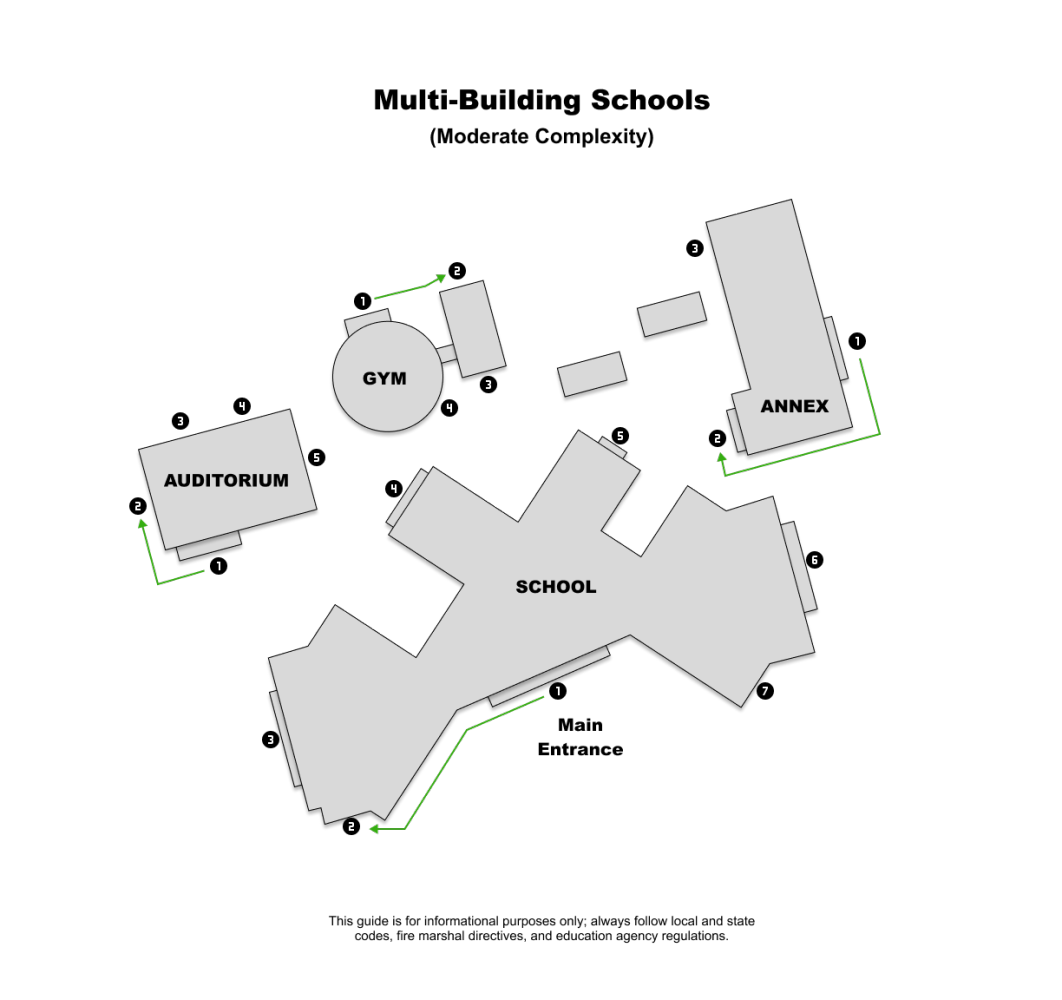
3. Legacy-Expansion Campuses
Older schools often evolve with add-ons, winding corridors, and portables, resulting in irregular layouts with low visual consistency.
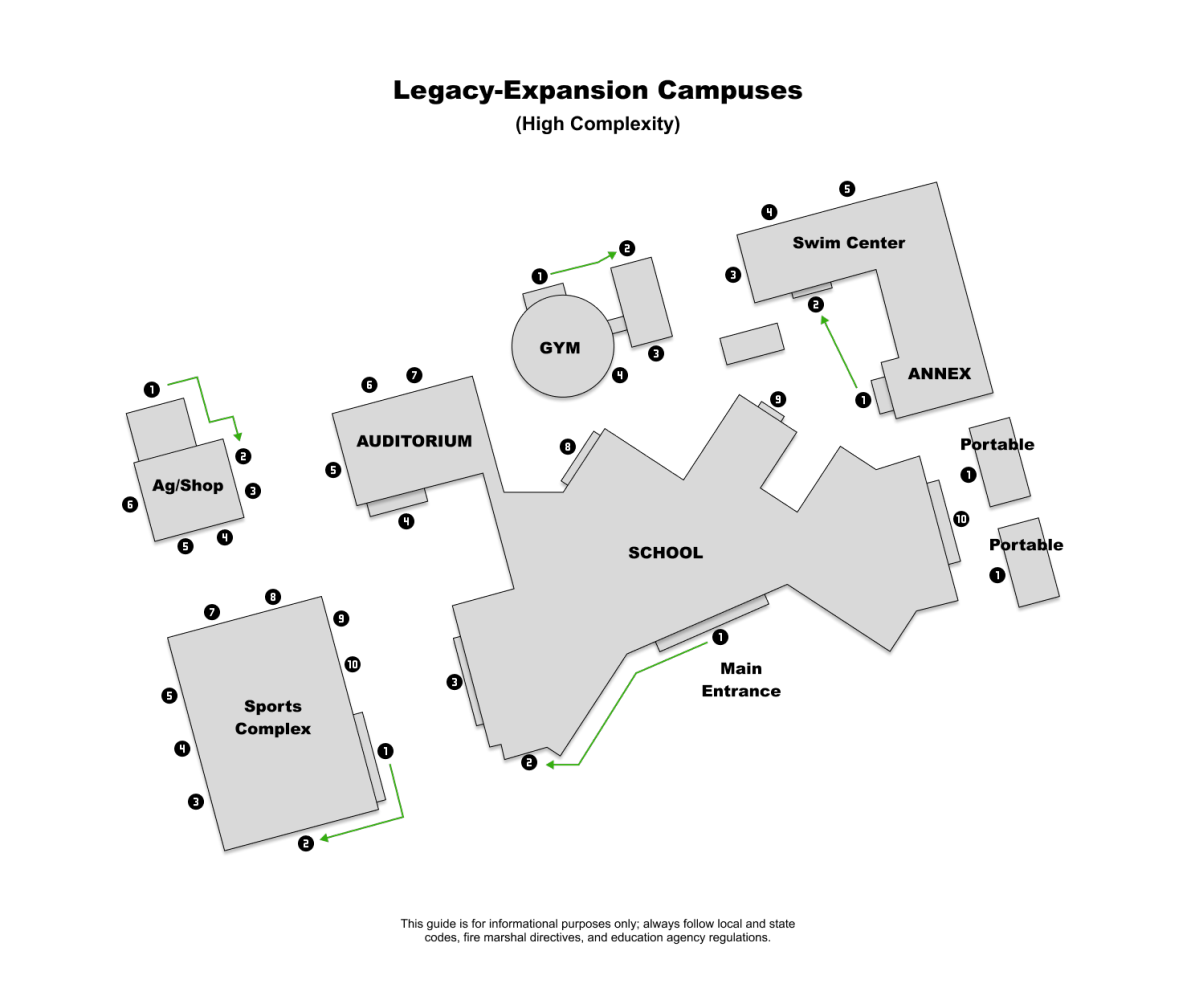
Note: All three example layouts reflect the Local (Reset) method, where door numbering restarts within each building or zone.
Define Your Labeling Philosophy Early Before printing decals, painting numbers, or assigning door labels, your district should make a key philosophical decision: Will you use a Global (Continuous) or Local (Reset) labeling approach?
In practice, many districts end up using a combination of both methods—due to varying campus layouts, renovations, or historical systems already in place. However, it's important to establish a primary strategy from the start. Doing so provides consistency, guides future expansion, and helps resolve conflicts when unique situations arise.
Local (Reset) Method
Door numbering restarts within each building or zone.
Example:
- Building A: Door 1, Door 2
- Building B: Door 1, Door 2
- Building C: Door 1, Door 2
Best for: Local navigation, smaller campuses, avoiding triple-digit labels.
Global (Continuous) Method
All doors across campus are labeled in a single, non-repeating sequence.
Example:
- Building A: Door 1, Door 2
- Building B: Door 3, Door 4
- Building C: Door 5, Door 6
Best for: Centralized tracking, data integration, emergency coordination.
What Qualifies as an Exterior Door?
An exterior door refers to any door that opens directly to the outside from an instructional space or supports campus operations. These doors play a critical role in emergency access, daily traffic flow, and perimeter control, and should be considered in your labeling and auditing process.
Examples include:
- Main entrances and vestibule access points
- Classroom doors that exit directly to the outside
- Portable classroom doors
- Side and rear egress doors
- Roll-up doors on instructional or operational buildings
- Gates that control access to or enclose secure areas
- Mechanical room doors (HVAC, boiler, electrical, etc.)
- Custodial or utility room doors with exterior access
- Receiving/shipping doors used for deliveries or dumpsters
- Exterior access doors to IT closets or server rooms
Special Note on Gates: Only include gates if they contribute to perimeter security and meet your city/state requirements (e.g., non-scalable, privacy-screened).
Labeling Strategies for Complex or Interconnected Campus Layouts
Campuses with interconnected buildings, multipurpose facilities, or irregular footprints require adaptable strategies. Two of the most effective approaches are:
1. Perimeter Flow Method
Follow the curvature of the building's footprint. Begin at a clear reference point—usually the main entrance—and number doors in a consistent clockwise direction.
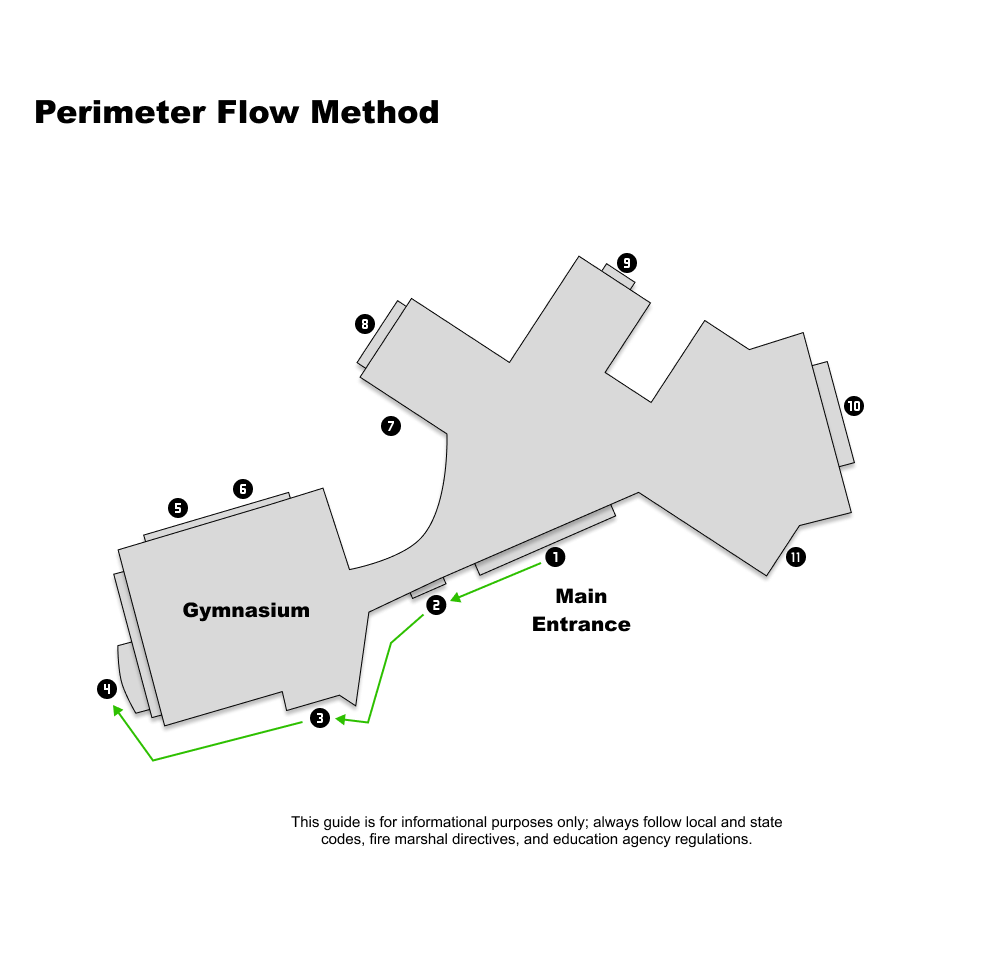
2. Zone-Based Method
Divide the campus into labeled zones by building or function (e.g., Admin, Fine Arts) and number within each.
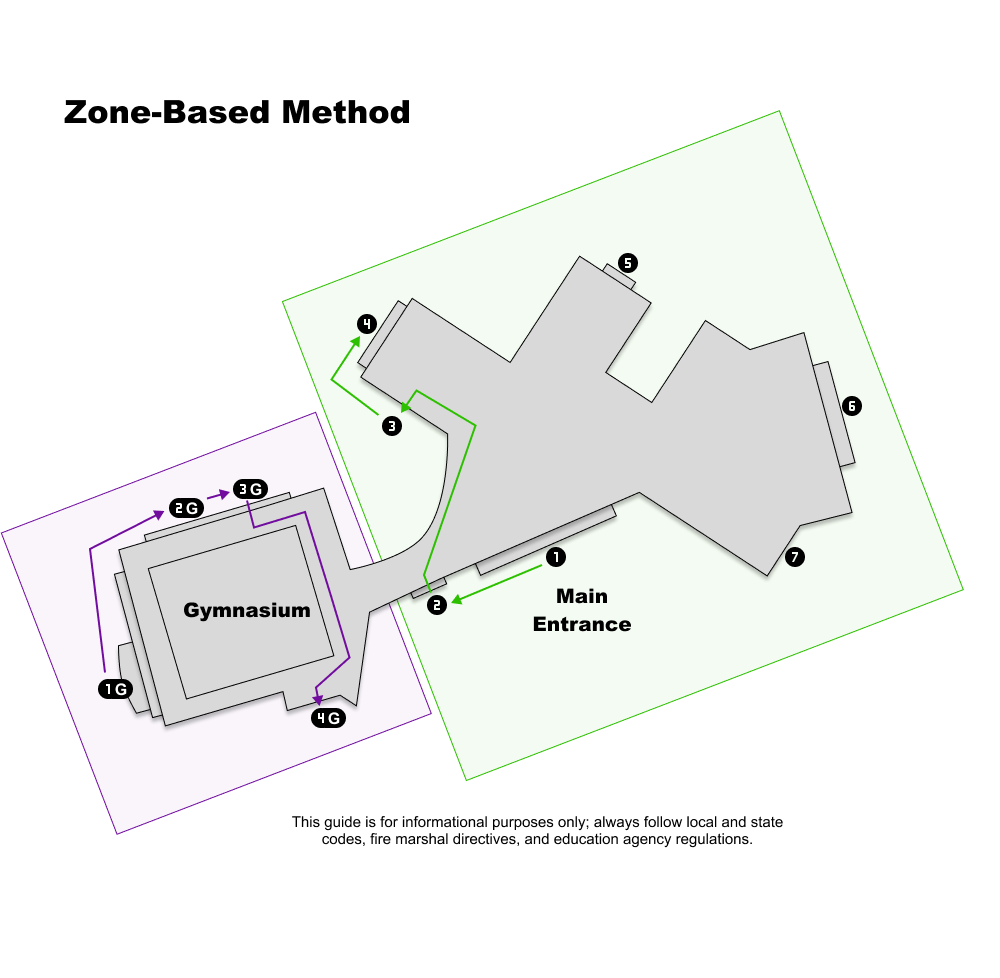
Pro Tip: Companies like Critical Response Group (CRG) specialize in critical incident mapping and campus mapping solutions that can integrate your existing door labeling system for both audits and emergency responders.
Building Side Designations: Alpha, Bravo, Charlie, Delta
These directional terms are widely used in emergency services, incident command systems (ICS), and fire pre-planning to identify the sides of a building consistently.
Standard Side Assignments:
- Side A (Alpha): Front of the building (main/public entrance)
- Side B (Bravo): Left side when facing the front
- Side C (Charlie): Rear of the building
- Side D (Delta): Right side when facing the front
Why It’s Used:
- Enhances communication clarity among staff, first responders, and safety personnel
- Eliminates confusion from subjective directions like “left” or “right”
- Commonly used in tactical maps, fire department pre-plans, and digital mapping platforms
Incorporating these directional prefixes into your door labels (e.g., Door A3, Door C2) can dramatically improve location accuracy and response coordination during critical incidents.
Best Practices for Labeling Doors
Materials & Visibility
- Vinyl decals (UV- and water-resistant)
- Font size: 7"–12"
- Bold, high-contrast color (white recommended)
- Non-glare vinyl for accessibility
Placement Guidelines
Exterior Placement: Labels should be applied to the upper outside corner of each door or door frame. This placement ensures high visibility for staff, security personnel, and first responders during emergency situations or routine audits. It also helps maintain consistency across various door types and building styles.
Interior Placement: A secondary label should be placed on the lower inside corner of the door. This positioning is intentional: in situations involving smoke, fire, or an active threat, individuals may need to crawl along the floor to stay safe. A low-mounted interior label can provide critical location information to evacuees, law enforcement, or responders operating in low-visibility or high-stress environments.
“A good rule to follow,” says Ethan Killeen, CTO and Co-Founder of Critical Response Group (CRG), “is that a door label should be visible from both the outside and inside of a building—whether the door is closed or propped open.”
Managing Door Labels Through Campus Changes
Campuses are living systems. Over time, doors are added, removed, or reconfigured—through renovations, expansions, or new construction. Whether it's a new wing, relocated entrance, or a structural connection between buildings, these changes require updates to your labeling system to avoid confusion and maintain clarity.
Scenario: When Buildings Become Connected
Let’s say your high school’s main building and adjacent auditorium each had their own main entrances labeled “Door 1.”
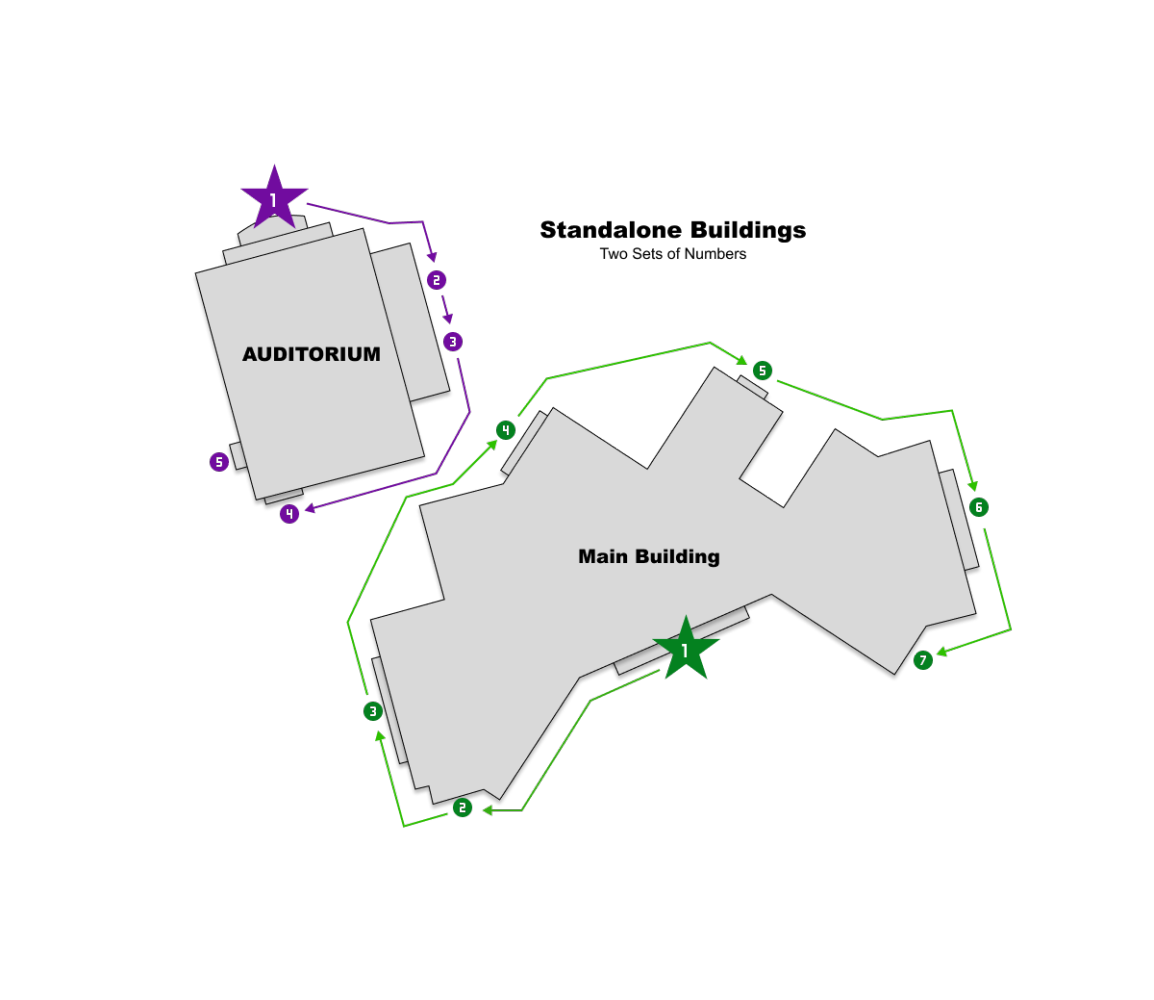
Over the summer, a secure breezeway is built to connect the two buildings. The new enclosed walkway includes exterior side egress doors, and both original entrances still display “Door 1.”
This creates several issues:
- Duplicate door numbers now exist within a connected structure
- New exit doors aren't covered in the original numbering plan
- Digital records and maps may conflict or become outdated
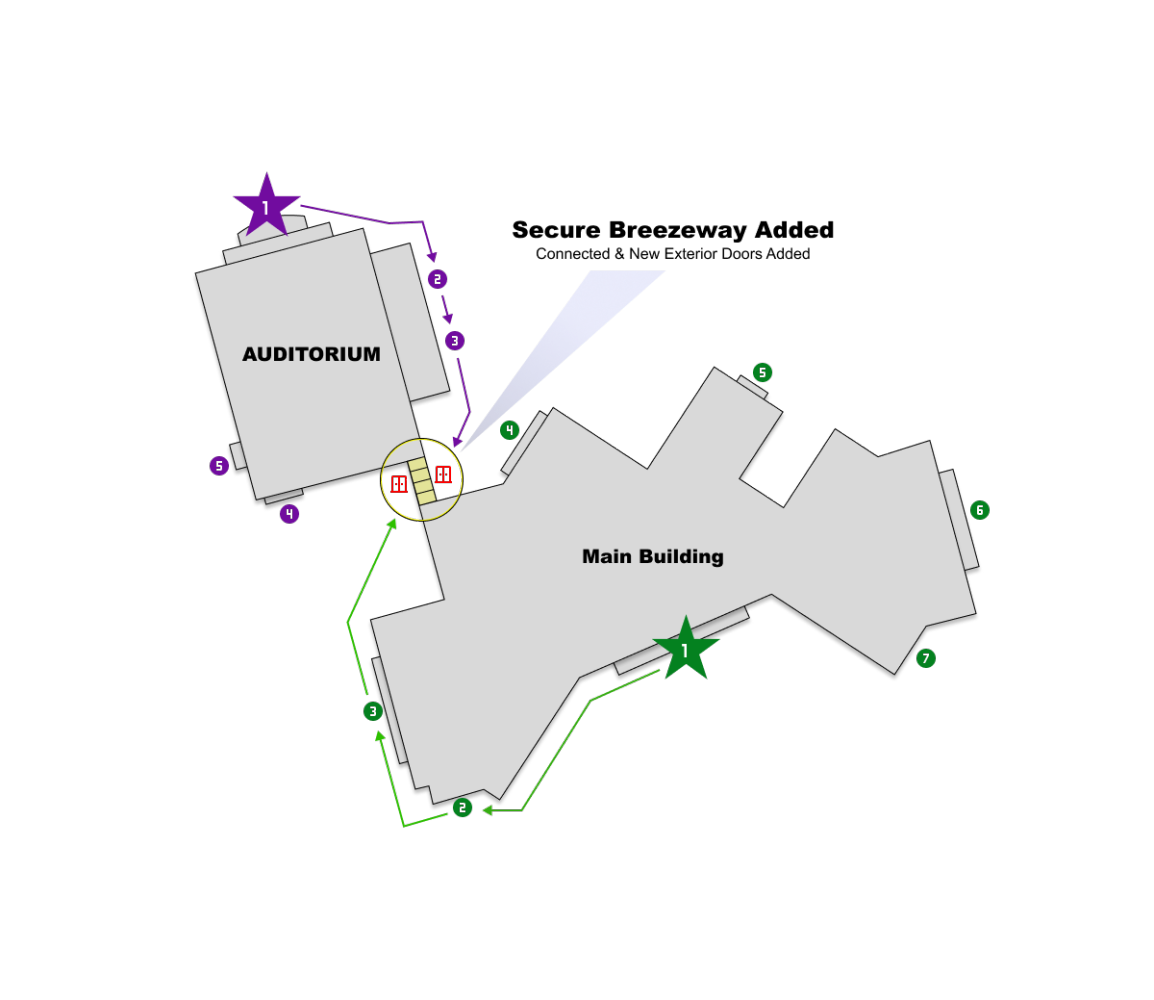
Solution 1: Implement Alphanumeric Labels for the Auditorium and Breezeway Zone
To resolve the labeling conflict while minimizing disruption to existing systems:
- Update the Auditorium Door Labels Using an Alphanumeric Format Reassign existing auditorium doors using a unique prefix (e.g., 1AUD, 2AUD, 3AUD...) to clearly distinguish them from the main building, which can retain its current numeric labeling (e.g., Door 1, Door 2…).
- Label the Breezeway as a New Zone Treat the newly constructed breezeway as its own distinct zone, and assign labels using a separate alphanumeric prefix (e.g., 1BW, 2BW) for the side egress doors.
This solution keeps the main building’s existing sequence intact, avoids duplication, and provides clear visual and logical separation between all connected structures.
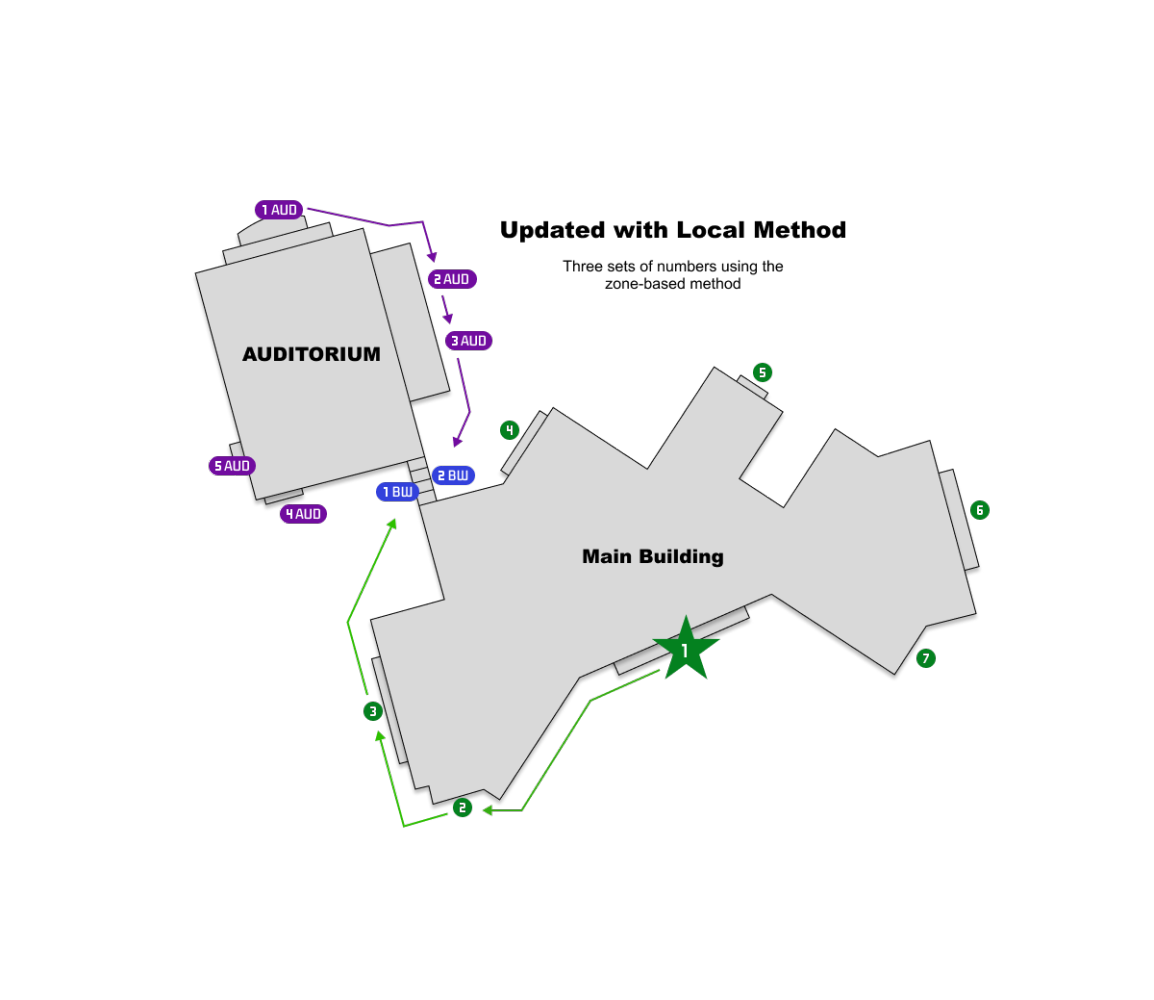
Solution 2: Reassign All Labels in a Unified Clockwise Sequence
To establish a clean, consistent system across the connected buildings:
- Remove Existing Labels from Conflicting Doors Eliminate the current labels on Auditorium doors 4, 5, 1, and 3, as well as School doors 4, 5, 6, and 7. This clears the way for a unified labeling sequence.
- Reassign Labels in a Logical Clockwise Order Starting from a clearly defined reference point—such as the main building entrance—renumber all doors (including the new breezeway exits) in a continuous clockwise flow across the entire connected structure. This solution ensures complete consistency, eliminates duplicate or out-of-sequence numbers, and reflects the campus’s updated physical layout in a clean, easy-to-follow format.
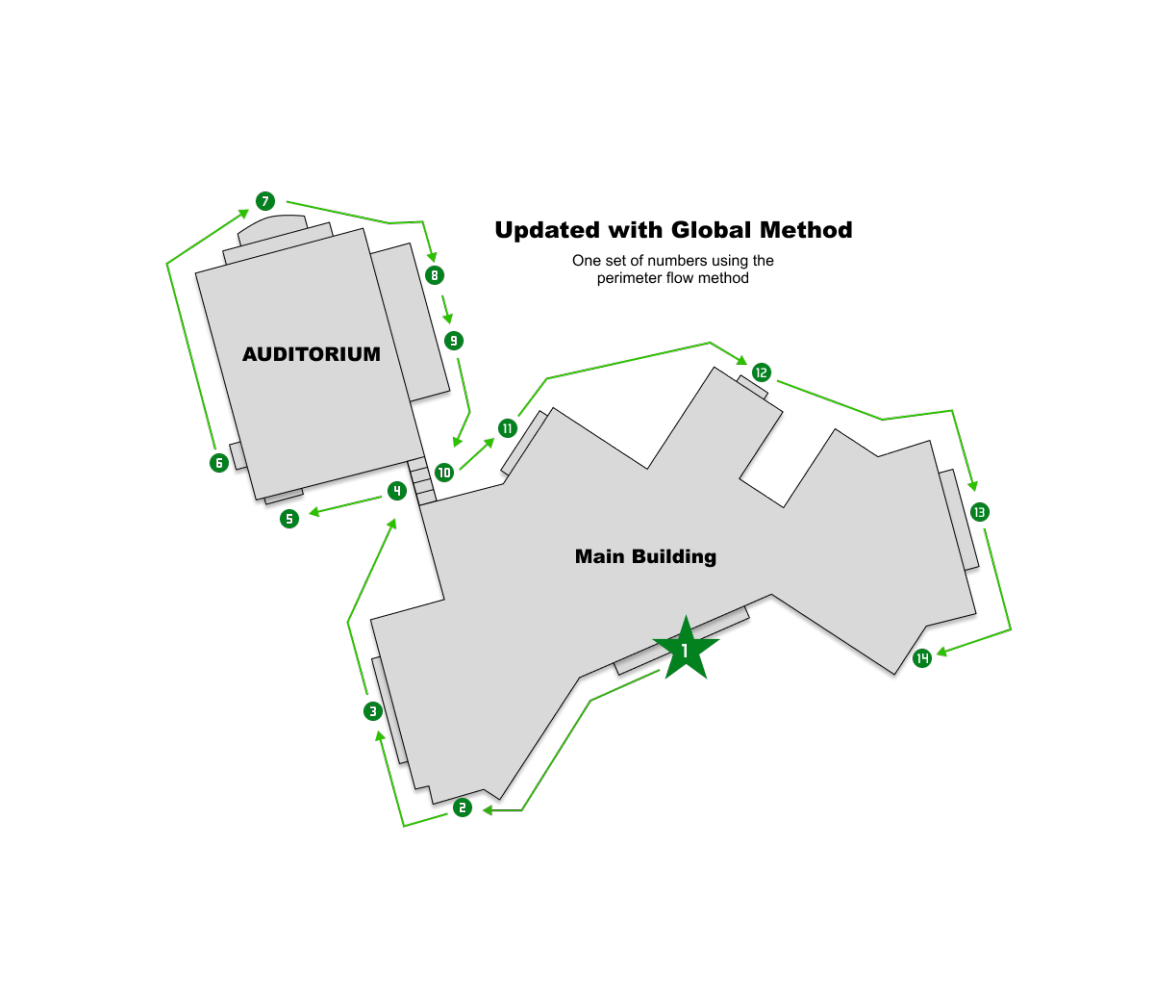
Alternatives to Handling Door Additions and Removals
When a New Door is Added:
- Avoid shifting every door number downstream, which causes confusion and breaks continuity with older records and maps.
- Use suffixes to insert new doors. If a new door is added between Door 12 and Door 13, label it 12A (or 12B, if multiple are added).
- Update your master record. Log the new door number, its physical location, building/zone, and purpose.
- Adjust plans and digital systems. Sync new door numbers with mapping, facility software, and emergency documentation.
When a Door is Removed or Permanently Sealed:
- Retire the number but don’t reuse it. Mark it as inactive in your records to preserve historical continuity (e.g., for audit trails or renovation tracking).
- Leave the number out of future sequences. Don’t assign a new door as "Door 9" if Door 9 was previously retired—even if it feels like a gap.
- If visibility remains, consider removal of decal. Remove or cover the label physically if the door is no longer functional, to avoid confusing staff or responders.
General Tips:
- Review door numbers during construction walkthroughs. Label doors as part of your closeout process after renovations or additions.
- Communicate changes to admin, safety personnel, and maintenance teams as part of a change log or alert.
- Batch updates when possible. If a building is undergoing multiple changes, reassign and re-label a full section of doors in clockwise order to re-establish a clean, logical sequence.
Update Maps and Communicate Changes
Any structural connection or layout shift should trigger updates to:
- Staff-facing safety maps
- First responder campus guides
- Mapping systems used by platforms like DoorCheck and Critical Response Group (CRG)
Training & Communication
After labeling is complete, ensure the system is clearly communicated to:
- Maintenance and custodial teams
- Campus security personnel
- Administrative staff
- Local law enforcement and emergency responders
Frequently Asked Questions
Should I use numbers, letters, or a combination?
We recommend using sequential numbers, beginning with 1. This keeps things simple and reduces confusion.
How should I determine the order of doors?
Start at the main entrance and proceed in a clockwise direction around each structure.
What if my campus has multiple buildings?
Use Global (continuous) or Local (reset) methods—just stay consistent.
What if an entrance has multiple doors?
There are three valid approaches: you can label the entire set as a single entrance (e.g., “Entrance 1”), assign a unique number to each individual door (e.g., Doors 1, 2, 3, 4), or use a sub-labeling system that combines a main number with suffixes (e.g., Door 1A, 1B, 1C, 1D).
Should I label gates?
Yes—if gates are used to secure instructional areas or restrict access, they should be labeled and routinely checked for functionality and integrity.
Final Thoughts
A thoughtful, consistent door labeling strategy improves daily operations, audit readiness, and emergency response. As your district evolves, so should your labeling approach.
Start with a pilot campus, gather feedback, and refine the process before rolling it out district-wide.
⚠️ Disclaimer
This guide is intended to support best practices. Always consult your local and state building codes, fire marshal guidelines, and education agency requirements before implementation. Code compliance may vary by region.